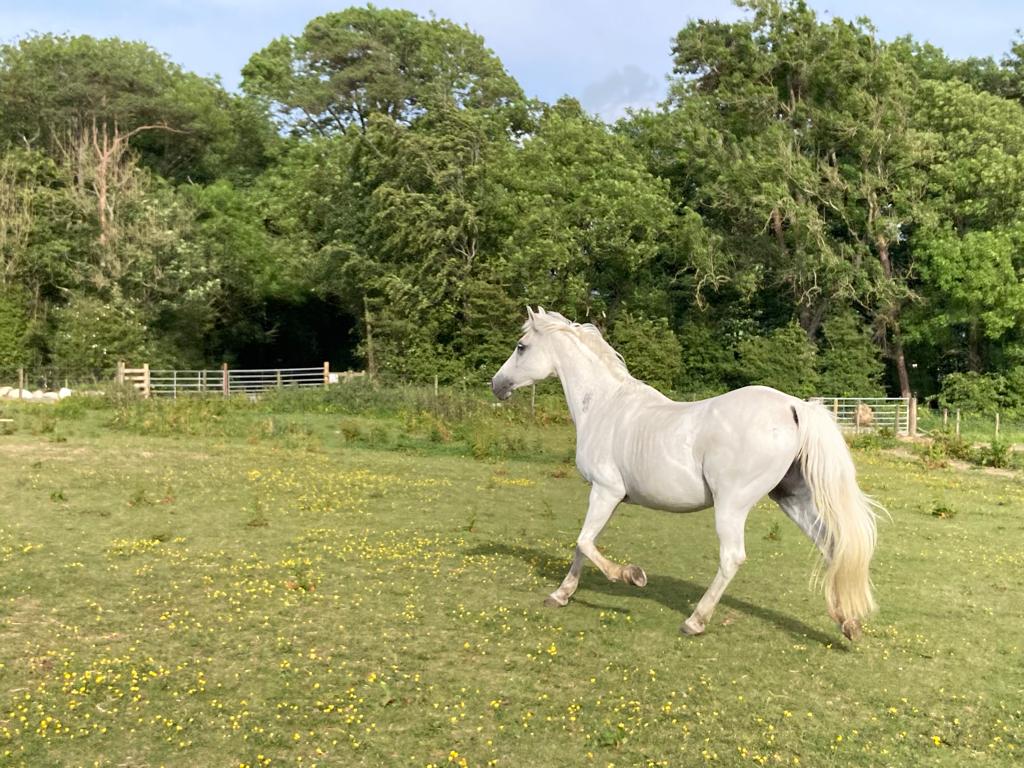
Laminitis
What is laminitis
Laminitis, in its simplest form, is inflammation of the sensitive layers (laminae) of the hoof resulting in pain, inflammation and, in some cases, permanent damage to the laminae. The laminae are interwoven specialised ‘leaves’ of tissue which suspend the pedal bone within the hoof. In very mild cases, appropriate treatment will resolve the problem with no lasting effect. If the inflammation is more severe and progressive, the sensitive laminae may lose their blood supply, resulting in loss of support between the pedal bone and horny hoof wall. This can lead to separation of the pedal bone from the hoof with rotation and/or sinking of the bone within the hoof. In severe cases penetration of the sole by the tip of the pedal bone can follow, with fatal consequences

Typical stance of pony suffering from laminitis
Symptoms
Laminitis is characterised by lameness involving one or more feet which is often rapid in onset. Most often both front feet are affected, but hind feet can be involved as well. Occasionally laminitis occurs in only one foot, often as a result of excessive load bearing due to a severe lameness of the opposite leg. Affected horses show a characteristic, pottery gait landing with the heel first. The condition is much worse when asked to walk on a firm surface or when turning. When resting, they often weight shift and stand with the hind limbs placed further underneath the body.
Physical examination usually identifies an increase of the digital pulse and often (but not always) the foot feels hot. Application of hoof testers to the sole in front of the frog will result in a painful response.
Diagnosis
The diagnosis is often made on the basis of the above findings at the clinical examination, but x-rays may be needed to formulate a treatment protocol and prognosis. These x-rays can often be taken at the yard with a portable unit to minimise stress for your horse.
Common causes of laminitis?
- Carbohydrate overload - excess grain or spring grass.
- Changes in glucose metabolism as a result of endotoxaemia caused by colic, intestinal infections or by infection in the uterus (womb) following foaling (retained placenta).
- Equine Cushing’s Disease. A disease of older horses and ponies in which an overgrowth of the pituitary gland results in overproduction of hormones that are thought to be responsible for the recurrent unexplained episodes of laminitis seen in sufferers.
- Equine Metabolic Syndrome. Usually seen in overweight middle-aged native ponies in which the fat stores become metabolically active and result in insulin resistance and recurrent episodes of laminitis.
- There is an unproven relationship between high doses of steroids administered to your horse and laminitis. Normal ‘safe’ doses carry a very minimal risk.
Treatment
If the underlying cause of the laminitis is known, then treatment for the primary disease is indicated. Furthermore, the horse should be on strict box rest in a deep bedding of sand or shavings. Pain relief will be provided to your horse by your veterinary surgeon in the form of pain-killer anti inflammatory drugs e.g. bute.
Diet
Many horses with laminitis are overweight and a specific diet should be discussed with your veterinary surgeon. In most cases it will involve a diet of small amounts of roughage only with no other treats. It may seem cruel, but is in the best interests of the patient. It is important though, that your horse still receives adequate nutrition and is not suddenly starved, as this can have potentially fatal consequences
Remedial farriery
Hoof care is pivotal in the treatment of laminitis. In the early phase the goal is to stabilise the pedal bone. This can be partially accomplished by transferring weight from the hoof wall to the sole surface, support can be provided with Lily or Styrofoam pads. In the chronic phase the goal is to minimise further rotation and to continue support for the sole, bars and frog with trimming and the use of specialist shoes.
Further investigation
Blood tests may be warranted in the case of Cushing’s Disease or other metabolic disorders to confirm the presence of underlying disease and start additional treatment.
Recurrence
Despite all efforts some horses experience unexpected relapses and early detection of these can be essential for your horse’s survival. Discuss with your veterinary surgeon how to detect the early signs and how to feel a digital pulse.
